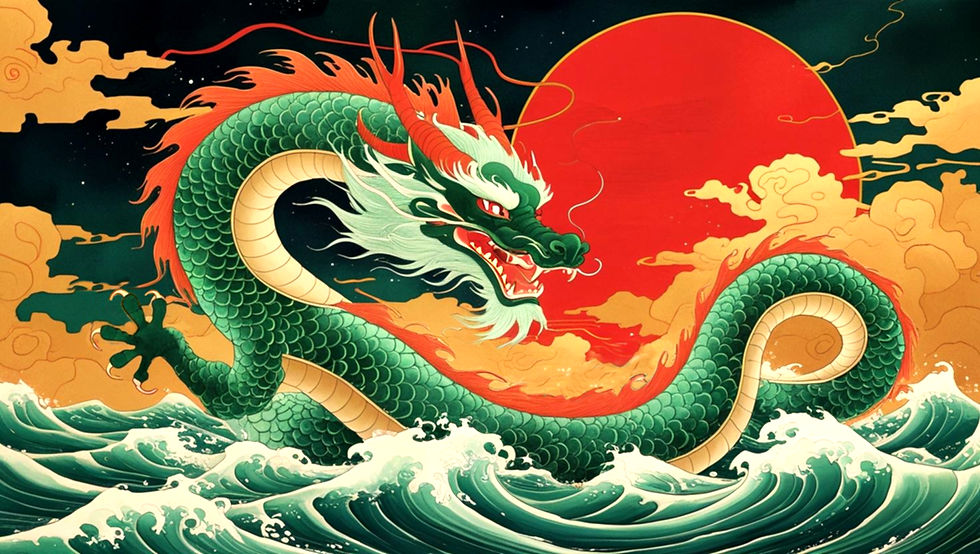Mystical Creatures: The Differences Between Western and Eastern Dragons — What Sets Them Apart?
- Mel Bridges

- Apr 3
- 4 min read
Updated: May 2

For centuries, humans have been enthralled by the mystique of dragons, a symbol of awe-inspiring power, profound wisdom, and unexplained mysteries that transcend cultures worldwide. Yet, despite their global allure, these legendary creatures have taken on distinct forms across continents, shaped by the intricate tapestries of mythology, culture, and history that define each region.
We’ll explore these fascinating creatures from both the Western and Eastern cultural perspectives and historical traditions, revealing the characteristics and features that set them apart.
Western Dragons: Fire-Breathing Beasts

In Western cultures, particularly in European folklore, dragons are depicted as fire-breathing monsters that unleash terror on villages and hoard treasure. This dark image has its roots in ancient Mesopotamian mythology, where dragons embodied chaos and the underworld.
It was the Greeks and Romans who cemented this notion of dragon terror, portraying these creatures as monstrous beings that brave heroes outsmarted and vanquished.
In the realm of Greek mythology, dragons originated as large serpents, often with many heads. They were found in water or guarding treasure in a mysterious location. The Colchian dragon, known for never sleeping and guarding the golden fleece in the myth of Jason and the Argonauts, is an example of this type of dragon.
Typhon — the last offspring of Gaia, the primordial earth goddess, and Tartarus, the underworld deity — is another formidable figure in Greek mythology and is depicted as a gigantic creature with a humanoid torso and serpentine lower body. Typhon with his mate Echidna produce terrifying offspring. The above-mentioned Colchian dragon is one of Typhon's children.

Typhon is considered one of the deadliest and most chaotic monsters of Greek lore; he is capable of breathing fire from both his mouth and eyes. He sought to usurp Zeus' throne and claim dominion over the cosmos. In a climactic showdown, Zeus confronts Typhon, determined to vanquish this monstrous threat. The king of the gods unleashed his mighty thunderbolts and hurled an enormous boulder at the serpentine dragon, dealing a crushing blow that ultimately defeated him.
The conquered Typhon was either thrown into the darkest depths of Tartarus or buried beneath the fiery slopes of Mount Etna. Some later accounts even rumored that he was imprisoned on the island of Ischia, a fate no less foreboding.

The Western tradition of depicting dragons as evil took hold in medieval Europe, where they were typically shown as serpentine or two-legged beasts. In the Book of Revelations, Michael and his angels had a cosmic battle with the “great dragon” called Satan and his fallen angels (Rev. 12:7-9).
In Christian tradition, Michael's triumph over Satan represents God's authority being upheld through His archangel, who leads the heavenly host. This pivotal battle symbolizes the eternal struggle between good and evil, commonly depicted in Christian art and literature as a cosmic representation of God's divine authority.

The legend of Saint George and the Dragon is a prime example of this type of narrative. In it, a Christian knight battles to save a princess from the clutches of a fire-breathing dragon, cementing the notion that dragons are evil creatures to be vanquished by heroes.
In traditional European folklore, heroes were not always the sole destroyers of dragons. In some tales, a brave warrior from the common folk or a clever peasant might defeat a dragon. The dragon is sometimes seen as a protector of the land or even a noble creature.
Eastern Dragons: Serpentine Symbols of Good Fortune and Wisdom

In stark contrast to their Western counterparts, Eastern cultures have long revered dragons as benevolent, serpentine creatures deeply connected to nature’s rhythms. Asian traditions often associate these serpentine beings with good fortune, prosperity, and wisdom. Eastern dragons are commonly portrayed as powerful aquatic deities, wielding sea-faring powers.
The Chinese dragon, known as long or lung, embodies the Emperor’s power and wisdom while signifying the cycles of life, death, and rebirth. In Japan, the ryū (Japanese dragon) is often associated with water and good fortune, serving as a guardian of the ocean and its creatures. Korean mythology features the yeongwangsa, a powerful dragon that rules over the seas and skies. Dragons (rồng) are portrayed as wise guardians and protectors, even as ancestors of the people according to Vietnamese lore.
Differences Between Western and Eastern Dragons
What sets Western and Eastern dragons apart? The main distinctions lie in their physical characteristics, behaviors, and symbolic meanings.
Physical Appearance: Western dragons are most typically depicted as fire-breathing, winged creatures, while Eastern dragons are serpentine with no wings.
Behavior: Western dragons are often portrayed as evil, destructive forces, whereas Eastern dragons are seen as benevolent, wise, and protective of the natural world.
Symbolism: In Western cultures, dragons represent chaos, evil, and destruction, whereas in Eastern cultures, they embody good fortune, wisdom, prosperity, and balance.
It is worth noting that the characteristics listed above share similarities across various Western and Eastern cultures, some nuances differ between traditions. These descriptions should be considered general attributes rather than absolute and exhaustive definitions.
Conclusion
The divergence between Western and Eastern dragon mythology serves as a testament to the diverse cultural and historical contexts that have shaped human imagination over time. While both types of dragons continue to captivate our imagination, their differences highlight the unique perspectives and values of each region.
By exploring these contrasting depictions, we can better appreciate the intricate connections between nature, mythology, and human culture. Whether you’re drawn to the fiery majesty of Western dragons or the serpentine wisdom of Eastern dragons, one thing is certain—the allure of these mythical beasts will continue to inspire our imagination for generations to come.
Check out short video (about 7 minutes):
Check out long video (about 24 minutes):






Comments